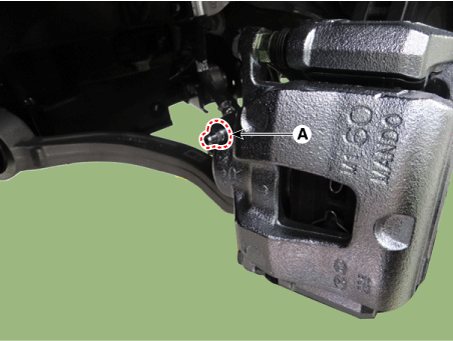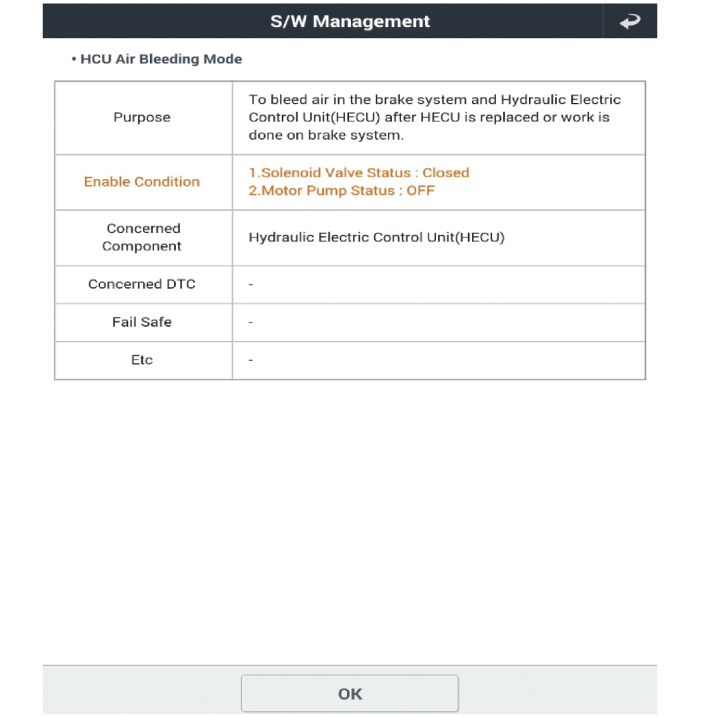Kia Stinger: Brake System
Special service tools
| Special Service Tools |
|
Tool Name / Number |
Illustration |
Description |
|
Piston expander 09581-11000 |
|
Spreading the front disc brake piston |
Brake bleeding procedures
| Adjustment |
Brake System Bleeding
|
| 1. |
Make sure that the brake fluid in the reservoir is filled upto the MAX (upper) level line. |
| 2. |
Have someone slowly pump the brake pedal several times, and then apply pressure. |
| 3. |
Loosen the rear right-hand side brake bleed screw (A) to allow air to escape from the system. Then tighten the bleed screw securely. [Normal brake] Front
Rear
[Brembo brake]
Front
Rear
|
| 4. |
Repeat the procedure for all wheels in the sequence shown below until air bubbles no longer appear in the fluid. [Normal brake]
[Brembo brake]
|
| 5. |
Refill the master cylinder reservoir upto the MAX (upper) level line.
|
ESP Bleeding of Brake System
Follow this procedure to ensure adequate bleeding of air and filling of the ESP unit, brake lines and master cylinder with brake fluid.
| 1. |
Remove the reservoir cap and fill the brake reservoir with brake fluid.
|
| 2. |
Connect a clear plastic tube to the wheel cylinder bleeder plug and insert the other end of the tube into a half filled clear plastic bottle. |
| 3. |
Connect the KDS to the data link connector located underneath the dash panel. |
| 4. |
Select and operate according to the instructions on the KDS screen.
|
| 5. |
Pump the brake pedal several times, and then loosen the bleeder screw until fluid starts to run out without bubbles. Then close the bleeder screw (A). [Normal brake] Front
Rear
[Brembo brake]
Front
Rear
|
| 6. |
Repeat step 5 in the order shown below until there are no more bubbles in the fluid for each wheel. [Normal brake]
[Brembo brake]
|
| 7. |
Tighten the bleeder screw.
|
Troubleshooting
| Troubleshooting |
| Problem Symptoms Table |
Use the table below to help you find the cause of the problem. The numbers indicate the priority of the likely cause of the problem.
Check each part in order.
If necessary, replace these parts.
|
Symptom |
Expected cause |
Countermeasure |
|
Lower pedal or sponge pedal |
Brake system (oil leakage) |
Repair |
|
Brake system (air inflow) |
Air bleeding out procedure |
|
|
Piston seal (worn out or damaged) |
Replace |
|
|
Rear brake shoe separation (faulty adjustment) |
Adjust |
|
|
Master cylinder (malfunction) |
Replace |
|
|
Dragged brake |
Brake pedal free separation (minimum) |
Adjust |
|
Parking brake cable length (adjustment trouble) |
Adjust |
|
|
Parking brake cable (trapped) |
Repair |
|
|
Rear brake shoe separation (adjustment trouble) |
Adjust |
|
|
Pad and lining (twisted or cracked) |
Replace |
|
|
Piston (trapped) |
Replace |
|
|
Piston (frozen) |
Replace |
|
|
Anker or return spring (malfunction) |
Replace |
|
|
Booster system (leakage of vacuum) |
Repair |
|
|
Master cylinder (malfunction) |
Replace |
|
|
Uneven brake |
Piston (trapped) |
Replace |
|
Pad and lining (oil stain, cracked or twisted) |
Replace |
|
|
Heavy pedal and brake trouble |
Brake system (oil leakage, air inflow) |
Perform air bleeding procedure |
|
Pad or lining (worned out) |
Replace |
|
|
Pad or lining (cracked or twisted) |
Replace |
|
|
Rear brake shoe separation (adjustment trouble) |
Adjust |
|
|
Pad or lining (oil stain) |
Replace |
|
|
Pad or lining (slippery) |
Replace |
|
|
Disc (scratched) |
Replace |
|
|
Booster system (leakage of vacuum) |
Repair |
|
|
Noise from brake |
Pad or lining (cracked or twisted) |
Replace |
|
Looseness of wheel bolt and caliper |
Adjust |
|
|
Pad sliding trouble (Pad uneven worn out) |
Replace |
|
|
Pad or lining (dirty) |
Cleaning |
|
|
Pad or lining (slippery) |
Pad replacement |
|
|
Anker or return spring (malfunction) |
Replace |
|
|
Brake pad shim (damaged) |
Replace |
|
|
Hold down spring (damaged) |
Replace |
|
|
Foreign substance stucked between disc and pad |
Cleaning |
|
|
Corrosion on disc |
Test drive brake and cleaning * get rid of corrosion by friction while test drive brake |
|
|
Caved disc |
Replace |
|
|
Not fully functioning on brake (when drive speed is fast) |
Pad or lining (worned out) |
Replace |
|
Master cylinder (malfunction) |
Replace |
|
|
Brake vibration |
Brake booster (leakage of vacuum) |
Repair |
|
Pedal free separation |
Adjust |
|
|
Master cylinder (malfunction) |
Replace |
|
|
Damaged on master cylinder cap |
Replace |
|
|
Damaged on brake line |
Replace |
|
|
Caliper returning trouble (while tire is turning, check the noise) |
Replace |
|
|
Transformed disc |
Replace |
- Specifications
- Brake System
- Brake Booster
- Vacuum Pump
- Master Cylinder
- Brake Line
- Brake Pedal
- Front Disc Brake
- Rear Disc Brake
- Stop Lamp Switch
- Parking Brake System
- ESP(Electronic Stability Program) System
- Emergency Signal System
- ESP Control Module
- Front Wheel Speed Sensor
- Rear Wheel Speed Sensor
- ESP OFF Switch
- Steering Angle Sensor
- Forward Collision-Avoidance Assist (FCA) System
 Active hood actuator assembly
Active hood actuator assembly
Repair procedures
Replacement
1.
Disconnect the negative battery terminal.
...
 Specifications
Specifications
Service data
Service data
Item
Specification
Master cylinder
Type
Tandem
Cylinder I.D.
Ă ...
Other information:
Kia Stinger CK 2018-2025 Owners Manual: Lane Keeping Assist (LKA) system
The Lane Keeping Assist (LKA) system is designed to detect the lane markers on the road with a front view camera at the front windshield, and assists the driver's steering to help keep the vehicle in the lanes. When the system detects the vehicle straying from its lane, it alerts the driver ...
Kia Stinger CK 2018-2025 Service Manual: Power Tailgate System
Components and components location Components 1. Anti pinch strip (2EA) 2. Power tailgate spindle (2EA) 3. Power tailgate buzzer 4. Side crash pad switch 5. Outside handle switch 6. Cluster (USM) 7. Power tailgate module (PTGM) 8. Power tail ...














